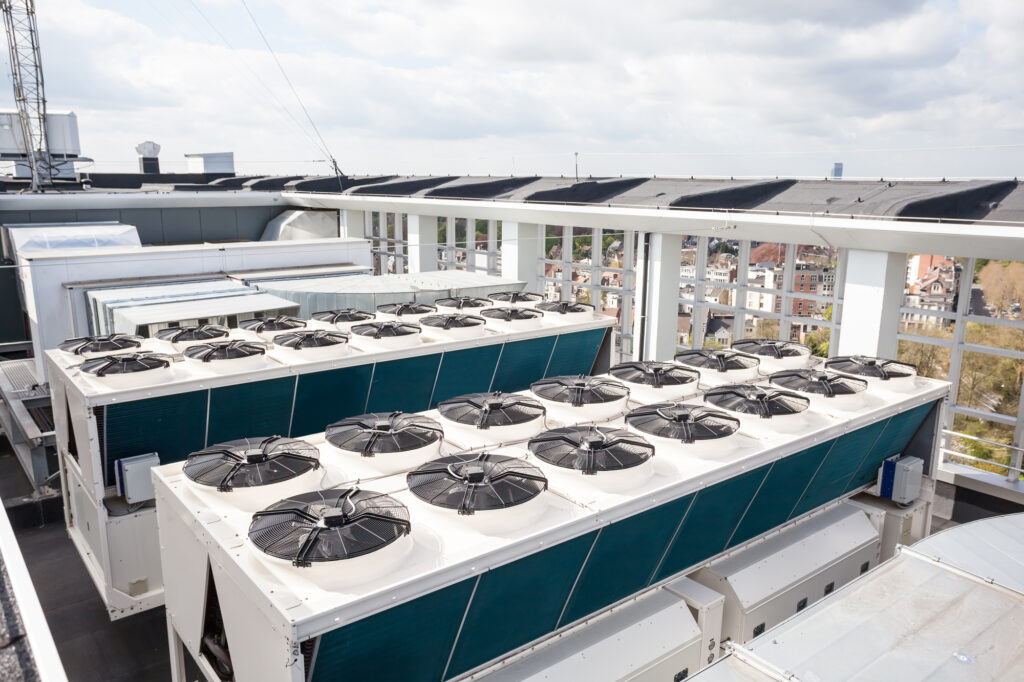Introduction to HVAC Systems
Did you know that the global market size for the HVAC industry is projected to reach $367 billion by the year 2030? With so much momentum behind the HVAC industry, there is an ever-increasing need for software to monitor and regulate these systems in commercial buildings and multi-tenant properties.
HVAC stands for “heating, ventilation, and air conditioning.” HVAC systems regulate temperature and air quality inside buildings. Depending on their application, HVAC systems take on a number of different shapes and sizes. Systems can range from simple window air conditioners to massive commercial systems. Overall, HVAC systems are essential for maintaining a comfortable environment in residential and commercial properties. It’s just as essential for facilities and property owners to properly regulate their usage in order to optimize economic and environmental efforts.
In this article, we’ll cover the basics of HVAC, including:
- Common HVAC Terminology to Know
- How Does an HVAC System Work?
- Shifting from Unregulated Overtime to Automated Overtime HVAC Control Systems
Common Terminology to Know
Before we dive in, let’s review some of the common HVAC terminologies you need to know as a facility or property manager. These terms are widely known throughout the industry.
- Thermostat: A control system that regulates temperature in a building by sending signals to air conditioners, furnaces, blowers, and fans.
- Furnace: The primary piece of equipment in a central heating system. Furnaces work by taking heat from a central source and moving it throughout a building.
- Heat pumps: Component used to regulate building temperatures in moderate climates. Heat pumps are installed outside and transfer hot and cold air from different areas of the building to regulate temperature.
- Central air conditioning/conditioner: A system that cools the air in a centralized location then moves it throughout a building with ductwork and fans.
- Ductwork: Open passages that run throughout a building to efficiently move air. Ductwork is a key component for centralized heating and air conditioning, as well as basic fresh air exchanges.
- Exhaust outlets: Vents within a building that allow for clear passage of hot, cool and clean air from ductwork into rooms.
- Heat exchangers: Systems used to transfer heat from “one medium to another.” Commonly used to make HVAC systems more energy-efficient.
- Split systems: HVAC units that have components both inside and outside of a building. Also known as “ductless” AC systems, the main heating or cooling source is located outside and connected indoors by way of copper tubing.
- Compressors: The piece of equipment responsible for creating pressure in air conditioning systems that eventually cools the refrigerant.
How Does an HVAC System Work?
There are 3 basic components in HVAC:
- Heating system
- Cooling system
- Ventilation
When all parts of an HVAC system work together, it moves hot, cool, and fresh air throughout a building.
Thermostats are manually controlled to regulate temperatures and airflow within a building. Depending on the programmed temperature, thermostats then send signals to AC units, furnaces, and heat pumps to warm or cool a space. Ductwork is the means by which air moves throughout a building to change the temperature and improve indoor air quality.
When working correctly, HVAC systems should essentially keep buildings comfortable in all four seasons. Even more, they should ensure that people always have fresh air to breathe when indoors.
Shifting from Unregulated After-Hours to Automated After-Hours HVAC Control Systems
While utility usage is at the forefront of most building teams’ minds, people often fail to account for after-hours consumption (e.g., holidays, hours when the building is not “open,” or is otherwise vacant). This is how unregulated after-hours HVAC usage could be costing you thousands of dollars in hidden expenses. Primary after-hours HVAC costs are:
- Equipment depreciation
- Billing leakage
- Energy use
- Associated labor
Additionally, in abnormally hot or cold climates, engineers may choose to run their HVAC system at a minimum load, rather than completely shutting down. This technique is done to avoid “losing the building,” which occurs when an HVAC system is shut down, then struggles to return to a comfortable temperature by the time the building opens the next day. Theoretically, if an engineer operating in a climate of extreme temperature decided to shut down the HVAC system completely, they would run the risk of “losing the building.”
After-hours HVAC eliminates the manual work required to run a minimum load. Further, if you choose the right software, you don’t need to be concerned with spending too much on utilities or losing control over conditions in your building.
On-demand HVAC scheduling software allows tenants to request service outside of regular service hours (e.g., holidays or the weekends). Unlike unregulated service, automated HVAC allows tenants to make recurring weekly or monthly schedules. Building teams then supply HVAC service only during the hours requested, saving everyone time and money.
What are some ways to cut costs/save on after-hours HVAC?
If you are wasting money on after-hours HVAC, there are some proactive steps you can take. By implementing an HVAC software platform, you can reduce unnecessary spending without having to disrupt day-to-day operations or compromise your tenants’ comfort.
We mentioned four after-hours costs; here are the ways you can offset those same after-hours HVAC expenses using flexible scheduling software:
- Equipment depreciation: Leaving HVAC equipment running after-hours is a surefire way to cause depreciation. Regulating your HVAC usage and schedule will reduce troubleshooting and preserve sensitive components such as refrigeration systems.
- Billing leakage: Tracking after-hours HVAC usage greatly reduces the chance of accounting errors of under or over-charging tenants.
- Energy use: On-demand HVAC will not only save your building thousands of dollars each year, it will also save on energy consumption. By having tenants go on-demand, you can maximize energy efficiency and automate HVAC requests.
- Associated labor: Automation and itemized functions take the guesswork and manual labor out of HVAC billing. This is how you can give your tenants a real-time view of utility usage.
In the end, monitoring, regulating and automating HVAC requests will help keep your tenants happy, while also protecting your bottom line.
How is Genea’s Automated Overtime HVAC Software Beneficial to Building Owners?
Property managers can save time and reduce unnecessary energy usage with Genea Overtime HVAC. The intuitive, user-friendly interface includes features that help you take back time from your busy day, so you can concentrate on what’s most important.
Designed for commercial buildings and portfolios, Overtime HVAC tracks HVAC usage by individual tenants in a building, automatically generates tenant invoices based on their after-hours consumption and streamlines billing processes.
Some of the features include:
- Advanced Filters – These help property managers search for the analytics they need to make data-driven decisions.
- Skip Workflow Stages– Customize the workflow that best suits you and your tenant. Property managers can choose to skip stages of the invoice process, such as the “in audit” step. If this step is skipped, the invoice is directly sent to the property manager for approval. Teams can also bypass manual invoice approval, instead having invoices directly approved by Overtime HVAC.
- Action Buttons– Easily edit invoices, request approvals and download invoices.
- Instantly View Change Requests– If a tenant changes their after-hours heating and cooling request, the property team can see it instantly.
- Linked Files for Auditing– Download files from the invoicing dashboard.
- Automated Email Notifications- Property managers can be automatically notified when tenants request an invoicing change or approve an invoice. For example, if a law office within a Class-A building finds a discrepancy or even just opens an invoice for review, the property manager will receive an email.
Generating after-hours heating and cooling invoices has never been easier. See how Genea OTHVAC can improve your workflow today.
Contact Genea Today
At Genea, we understand the challenges of running and maintaining HVAC systems in Class A commercial buildings. We are also aware of the financial impact that outdated HVAC management practices can have on a building owner’s bottom line.
Need a way to effectively monitor and bill for the after-hours HVAC requests at your property without having to be too hands-on?
Learn how Genea’s Overtime HVAC software can improve your building, tenants, and bottom line.



